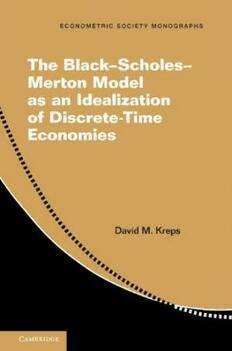
The Black-Scholes-Merton Model as an Idealization of Discrete-Time Economies PDF
Preview The Black-Scholes-Merton Model as an Idealization of Discrete-Time Economies
TheBlack–Scholes–MertonModelasanIdealization ofDiscrete-TimeEconomies This book examines whether continuous-time models in frictionless financial economiescanbewellapproximatedbydiscrete-timemodels.Itspecificallylooks toanswerthequestion:InwhatsenseandtowhatextentdoesthefamousBlack– Scholes–Merton(BSM)continuous-timemodeloffinancialmarketsidealizemore realistic discrete-time models of those markets? While it is well known that the BSM model is an idealization of discrete-time economies where the stock price process is driven by a binomial random walk, it is less known that the BSM model idealizes discrete-time economies whose stock price process is driven by more general random walks. After recounting the foundations of discrete- and continuous-time models of financial markets, David M. Kreps develops the gen- eraltheoryofconvergenceofdiscrete-timemodelstotheircontinuous-timelimits, bothinmathematicalandeconomicterms.Theexpositionlowerstheentrybarriers totheliteratureoffinancialmathematicsforless-technicalreaders,whileprovid- ing a fuller understanding of the connections between BSM and nearby discrete economies. David M. Kreps is the Adams Distinguished Professor of Management, Emeri- tus,attheStanfordGraduateSchoolofBusiness.Hehasbeenhonoredwithmany awards,includingtheJohnBatesClarkMedalbytheAmericanEconomicAssoci- ationin1989andtheJohnJ.CartyAwardfortheAdvancementofSciencebythe NationalAcademyofSciencesin2018. EconometricSocietyMonographSeries Editors: AndreaPrat,ColumbiaUniversity StéphaneBonhomme,UniversityofChicago TheEconometricSocietyisaninternationalsocietyfortheadvancementofeconomictheoryin relation to statistics andmathematics. The EconometricSociety Monographseries is designed to promote the publication of original research contributions of high quality in mathematical economicsandtheoreticalandappliedeconometrics. BooksintheSeries W.Thomson,HowtoDivideWhenThereIsn’tEnough:FromAristotle,theTalmud,and MaimonidestotheAxiomaticsofResourceAllocation,2019 O.Compte&A.Postlewaite,IgnoranceandUncertainty,2018 I.Molchanov&F.Molinari,RandomSetsinEconometrics,2018 B.Honoré,A.Pakes,M.Piazzesi,&L.Samuelson(eds.),AdvancesinEconomicsand Econometrics:EleventhWorldCongress,Vols.I&II,2017 S.Maurer,OntheShouldersofGiants:ColleaguesRememberSuzanneScotchmer’s ContributionstoEconomics,2017 C.P.Chambers&F.Echenique,RevealedPreferenceTheory,2016 J.-F.Mertens,S.Sorins,&S.Samir,RepeatedGames,2015 C.Hsiao,AnalysisofPanelData:3rdedn,2014 C.Cameron&P.Trivedi,RegressionAnalysisofCountData,2ndedn,2013 A.Harvey,DynamicModelsforVolatilityandHeavyTails,withApplicationstoFinancialand EconomicTimeSeries,2013 D.Acemoglu,M.Areilano,&E.Dekel(eds.),AdvancesinEconomicsandEconometrics: TheoryandApplications,TenthWorldCongress,Vols.I,II,&III,2013 M.Fleurbaey&F.Maniquet,ATheoryofFairnessandSocialJustice,2011 R.Vohra,MechanismDesign:ALinearProgrammingApproach,2011 K.Samphantharak&R.Townsend,HouseholdsasCorporateFirms:AnAnalysisofHousehold FinanceUsingIntegratedHouseholdSurveysandCorporateFinancialAccounting,2009 I.Gilboa,TheoryofDecisionunderUncertainty,2009 F.Vega-Redondo,ComplexNetworks,2007 R.Blundell,W.Newey,&T.Persson,(eds.),AdvancesinEconomicsandEconometrics:Theory andApplications,NinthWorldCongress,Vols.I,II,&III,2006 J.Roemer,Democracy,Education,andEquality,2006 C.Blackorby,W.Bossert,&D.Donaldson,PopulationIssuesinSocialChoiceTheory,Welfare EconomicsandEthics,2005 R.Koenker,QuantileRegression,2005 C.Hsiao,AnalysisofPanelData,2nded.,2003 M.Dewatripont,L.P.Hausen,&S.J.Turnovsky(eds.),AdvancesinEconomicsand Econometrics:TheoryandApplications,EighthWorldCongress,Vols.I,II,&III,2003 E.Ghysels,N.Swanson,&M.Watson(eds.),EssaysinEconometrics:CollectedPapersofClive W.J.Granger,Vols.I&II,2001 S.Strøm(ed.),EconometricsandEconomicTheoryinthe20thCentury:TheRagnarFrisch CentennialSymposium,1999 A.C.Cameron&P.K.Trivedi,RegressionAnalysisofCount-Data,1998 D.Jacobs,E.Kalai,&M.Kamien(eds.),FrontiersofResearchinEconomicTheory:TheNancy L. SchwartzMemorialLectures,1998 Continuedonpagefollowingtheindex The Black–Scholes–Merton Model as an Idealization of Discrete-Time Economies David M. Kreps StanfordUniversity,California UniversityPrintingHouse,CambridgeCB28BS,UnitedKingdom OneLibertyPlaza,20thFloor,NewYork,NY10006,USA 477WilliamstownRoad,PortMelbourne,VIC3207,Australia 314–321,3rdFloor,Plot3,SplendorForum,JasolaDistrictCentre, NewDelhi–110025,India 79AnsonRoad,#06–04/06,Singapore079906 CambridgeUniversityPressispartoftheUniversityofCambridge. ItfurtherstheUniversity’smissionbydisseminatingknowledgeinthepursuitof education,learning,andresearchatthehighestinternationallevelsofexcellence. www.cambridge.org Informationonthistitle:www.cambridge.org/9781108486361 DOI:10.1017/9781108626903 (cid:2)c DavidM.Kreps2019 Thispublicationisincopyright.Subjecttostatutoryexception andtotheprovisionsofrelevantcollectivelicensingagreements, noreproductionofanypartmaytakeplacewithoutthewritten permissionofCambridgeUniversityPress. Firstpublished2019 PrintedintheUnitedKingdombyTJInternationalLtd.PadstowCornwall AcataloguerecordforthispublicationisavailablefromtheBritishLibrary. ISBN978-1-108-48636-1Hardback ISBN978-1-108-70765-7Paperback CambridgeUniversityPresshasnoresponsibilityforthepersistenceoraccuracyof URLsforexternalorthird-partyinternetwebsitesreferredtointhispublication anddoesnotguaranteethatanycontentonsuchwebsitesis,orwillremain, accurateorappropriate. Contents Preface ix 1. Introduction 1 Proofs 5 Website 5 2. FinitelyManyStatesandTimes 6 TheExplicitModel 6 TheQuestionsAddressed 8 WhatSortofConsumers? 9 ⇐⇒ ⇐⇒ ⇐⇒ Viability NoFreeLunches PricingKernel EquivalentMartingaleMeasure 13 TwoGeneralizations 18 TwoExamples 20 WhichContingentClaimsCanBeSynthesized? 23 ArbitrageBoundsonthePriceofClaims 24 BibliographicNotes 28 3. CountinuousTimeandtheBlack–Scholes–Merton(BSM)Model 29 The(Limited)ScopeofThisChapter 29 TheBSMModel 30 DoublingStrategies 31 SimpleTradingStrategies 33 Fo¨llmer’sExample 37 GeneralizingProposition2.1: TheFundamentalTheorem ofAssetPricing(FTAP) 38 “ArbitragePricing”byViabilityArguments 42 “ArbitragePricing”bySynthesis 44 TheFinancial-GainsIntegral 48 IntheBSMModel,withContinuousTrading, MarketsAreComplete 51 Editorial: Continuous-TimeTradingasanIdealization 52 BibliographicNotes 54 4. BSMasanIdealizationofBinomial-Random-WalkEconomies 56 OneStateSpace 57 C[0,1] versus D[0,1] 58 vi Contents OneStateSpace,Continued 60 GeneralizingCox,Ross,andRubinstein 62 WeakConvergenceinGeneral 64 Donsker’sTheorem 68 ProofofProposition4.1 69 UnboundedandDiscontinuousContingentClaims 74 ConvergenceofSolutionstotheConsumer’sProblem: Formulation 77 ExistenceandCharacterizationofSolutions forDiscrete-TimeEconomies 79 ExistenceandCharacterizationofSolutionsfortheBSMEconomy 82 EmployingProposition4.4 87 ConvergenceofSolutionstotheConsumer’sProblem,Completed 88 ConcerningtheAssumptioninProposition4.4thatthe Bounds(4.2)Hold 96 OtherBinomialRandomWalks 96 SoIsBSMaGoodIdealizationofthe Binomial-Random-WalkEconomies? 98 BibliographicRemarks 99 5. GeneralRandom-WalkModels 100 TheEsscherTransformandemm 102 TheTrinomialRandomWalkandNearSynthesisoftheCallOption 107 AsymptoticSynthesisofContingentClaimsforGeneral Random-WalkEconomies 112 ProofStageI:AVerySpecialCase 114 ProofStageII:ALessSpecialCase,Begun 118 TheSkorohodRepresentationTheorem 119 StageIICompleted 120 ProofStageIII:GeneralContingentClaimsinThreeSteps 124 ConcerningtheProofofProposition5.1band theBoundednessoftheSupportof ζ 126 UnboundedClaims 127 What’sGoingonHere? “Arbitrage,”asDefined intheLiterature,AsksTooMuch 129 ArbitrageursversusConsumers 130 ConvergenceofOptimalConsumption,1: BoundedSupport 132 ConvergenceofOptimalConsumption,2: DiscreteTimeIs AsymptoticallyatLeastasGoodasContinuousTime 133 Contents vii ConvergenceofOptimalConsumption,3: IsDiscreteTime AsymptoticallyNoBetterthanContinuousTime? 137 ConvergenceofOptimalConsumption,4: CRRA(andCARA)Utility 139 Chapter4versusChapter5 146 TheBottomLine? 146 BibliographicNotes 147 6. Barlow’sExample 148 Background: TheCox–Ross–RubinsteinModels 149 Barlow’sExample 152 VariationsonBarlow’sExample 155 BarlowwithConsecutiveStepsCombined 155 ATwo-by-TwoSummaryTable 156 7. ThePo¨tzelberger–SchlumprechtExampleand AsymptoticArbitrage 158 TheExample 158 AsymptoticArbitrage–thePhilosophy 163 AsymptoticArbitrage–theTheory 167 NoAsymptoticArbitrage–theConsequences 169 8. ConcludingRemarks,Part1: HowRobustanIdealizationisBSM?171 9. ConcludingRemarks,Part2: Continuous-TimeModels asIdealizationsofDiscreteTime 174 Appendix 177 TwoEquivalentWaystoRepresentaFieldofEvents foraFiniteStateSpace 177 ProofofProposition4.2a 178 ProofofProposition4.4 183 SomeCalculationsfortheGeneralBinomialModel 186 (Asymptotic)SolutionsoftheConsumer’sExpected-Utility MaximizationProblemwithCARAUtility 188 References 194 AuthorIndex 199 SubjectIndex 200
